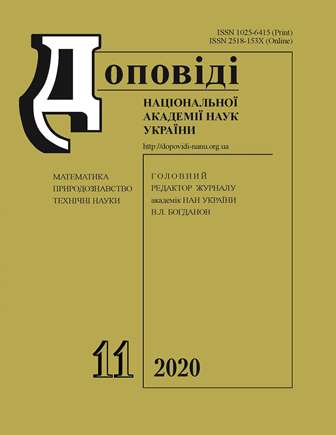Радіальний градієнт ультраструктури мітохондрій у коренях Pisum sativum L.
DOI:
https://doi.org/10.15407/dopovidi2020.11.078Ключові слова:
гіпоксія, корінь, мітохондрія, ультраструктураАнотація
Тканинна гіпоксія кореня наземних рослин у середовищі, насиченому киснем, обумовлена високою щільністю тканини та утилізацією кисню в процесі клітинного дихання і простежується у формі поступового зниження концентрації кисню від поверхні органу. Дану природну модель використано на прикладі головного кореня 5-добових проростків Pisum sativum L. для дослідження ультраструктури мітохондрій у тканині, де знижується вміст кисню. Встановлено, що у напрямі від поверхні кореня до ендодерми відбувається поступове збільшення розміру органел, обумовлене набряканням та частково злиттям органел. Утворення однієї глибокої інвагінації призводить до формування чашоподібних органел. Такі зміни в структурі органел названо радіальним градієнтом ультраструктури мітохондрій, який демонструє послідовну перебудову органел на фоні зниження концентрації кисню в тканині. Припускається, що зміна структури мітохондрій може бути неспецифічною відповіддю на дію чинників, які обумовлюють інгібування їхніх енергетичних та/ або метаболічних функцій.
Завантаження
Посилання
Van Dongen, J. T. & Licausi, F. (2015). Oxygen sensing and signaling. Annu. Rev. Plant Biol., 66, pp. 345-367. https://doi.org/10.1146/annurev-arplant-043014-114813
Wagner, S., Van Aken, O., Elsässer, M. & Schwarzländer, M. (2018). Mitochondrial energy signaling and its role in the low-oxygen stress response of plants. Plant Physiol., 176, pp. 1156-1170. https://doi.org/10.1104/pp.17.01387
Nakamura, M. & Noguchi, K. (2020). Tolerant mechanisms to O2 deficiency under submergence conditions in plants. J. Plant Res., 133, pp. 343-371. https://doi.org/10.1007/s10265-020-01176-1
Baker, N., Patel, J. & Khacho, M. (2019). Linking mitochondrial dynamics, cristae remodeling and supercomplex formation: How mitochondrial structure can regulate bioenergetics. Mitochondrion, 49, pp. 259-268. https://doi.org/10.1016/j.mito.2019.06.003
Armstrong, W. & Armstrong, J. (2014). Plant internal oxygen transport (diffusion and convection) and measuring and modelling oxygen gradients. In van Dongen, J., Licausi, F. (Eds.). Low-oxygen stress in plants (pp. 267-297). Plant Cell Monograpgs (Vol. 21). Vienna: Springer. https://doi.org/10.1007/978-3-7091-1254-0_14
Zabalza, A., Van Dongen, J. T., Froehlich, A., Oliver, S. N., Faix, B., Gupta, K. J., Schmälzlin, E., Igal, M., Orcaray, L., Royuela, M. & Geigenberger, P. (2009). Regulation of respiration and fermentation to control the plant internal oxygen concentration. Plant Physiol., 149, pp. 1087-1098. https://doi.org/10.1104/pp.108.129288
Gibbs, J., Turner, D. W., Armstrong, W., Darwent, M. J. & Greenway, H. (1998). Response to oxygen deficiency in primary roots of maize. I. Development of oxygen deficiency in the stele reduces radial solute transport to the xylem. Aust. J. Plant Physiol., 25, pp. 745-758. https://doi.org/10.1071/PP97135
Colmer, T. D., Winkel, A., Kotula, L., Armstrong, W., Revsbech, N. P. & Pedersen, O. (2020). Root O2 consumption, CO2 production and tissue concentration profiles in chickpea, as influenced by environmental hypoxia. New Phytol., 226, pp. 373-384. https://doi.org/10.1111/nph.16368
Van Gestel, K. & Verbelen, J. P. (2002). Giant mitochondria are a response to low oxygen pressure in cells of tobacco (Nicotiana tabacum L.). J. Exp. Bot., 53, pp. 1215-1218. https://doi.org/10.1093/jexbot/53.371.1215
Ramonell, K. M., Kuang, A., Porterfield, D. M., Crispi, M. L., Xiao, Y., Mclure, G. & Musgrave, M. E. (2001). Influence of atmospheric oxygen on leaf structure and starch deposition in Arabidopsis thaliana. Plant Cell Envir., 24, pp. 419-428. https://doi.org/10.1046/j.1365-3040.2001.00691.x
Rakhmatullina, D., Ponomareva, A., Gazizova, N. & Minibayeva, F. (2016). Mitochondrial morphology and dynamics in Triticum aestivum roots in response to rotenone and antimycin A. Protoplasma, 253, pp. 1299-1308. https://doi.org/10.1007/s00709-015-0888-0
Jaipargas, E.-A., Barton, K. A., Mathur, N. & Mathur, J. (2015). Mitochondrial pleomorphy in plant cells is driven by contiguous ER dynamics. Front. Plant Sci., 6, pp. 783. https://doi.org/10.3389/fpls.2015.00783
Ponomareva, A. A. & Polygalova, O. O. (2012). Changes in mitochondrial shape in wheat root cells exposed to mitochondrial poisons. Russ. J. Plant Physiol., 59, pp. 428-433. https://doi.org/10.1134/S1021443712030144
Vella, N. G. F., Joss, T. V. & Roberts, T. H. (2012). Chilling-induced ultrastructural changes to mesophyll cells of Arabidopsis grown under short days are almost completely reversible by plant re-warming. Protoplasma, 249, pp. 1137-1149. https://doi.org/10.1007/s00709-011-0363-5
Xi, Y. X. (1995). NaCl-induced amoeboid plastids and mitochondria in meristematic cells of barley roots. Biol Plant., 37, pp. 363-369. https://doi.org/10.1007/BF02913979
##submission.downloads##
Опубліковано
Як цитувати
Номер
Розділ
Ліцензія
Авторське право (c) 2023 Доповіді Національної академії наук України

Ця робота ліцензується відповідно до Creative Commons Attribution-NonCommercial 4.0 International License.




